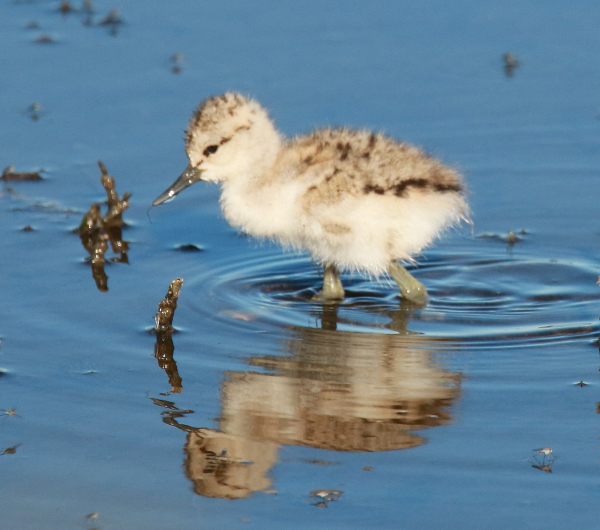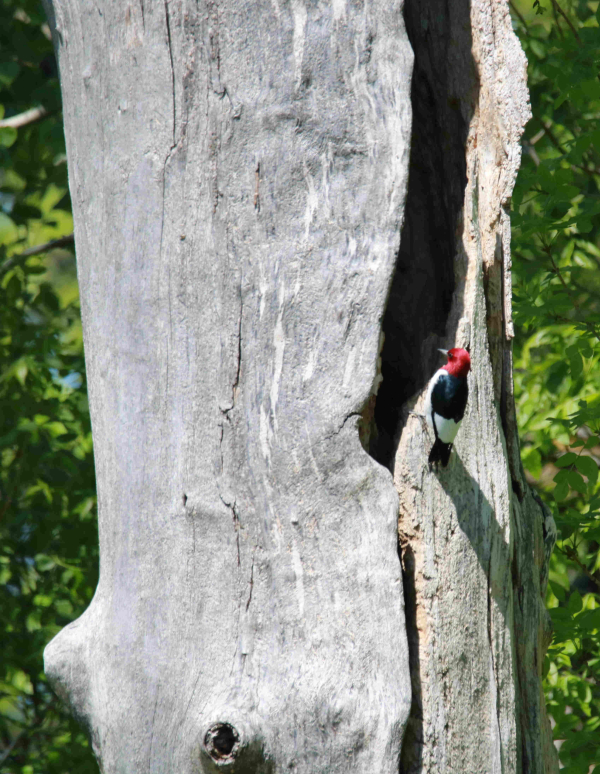
Just a few hours old, an American Avocet is already mobile and searching for food on its own, within the protective view of the adult pair and its brood mates.

A second opportunity to photograph the molting Krider’s Red-tailed Hawk provided a more natural setting as it perched in a cottonwood tree.

A Red-headed Woodpecker is dwarfed in size as it inspects the cavern inside the tall giant snag that stands no more on the edge of Melody’s Grove. It was a grand old tree, even as a barkless skeleton.
|
Eggs are hatching! Fledglings are leaving the nest! I found the first local duck brood last Wednesday evening, a newly hatched brood of 9 ducklings with an alert Mallard hen, along with a Northern Pintail brood of 4 Saturday eve. Closer to home, a beautifully colored fledgling robin graced my front yard as the first of the season, following the female on the ground. The robin was preceded by the first grackle fledglings Tuesday, and followed by a Mourning Dove fledgling Friday.
The variety of fledglings in my yard put me on extra high alert for cats in the area. But I have them pretty well controlled – just by barking loudly and intently like a mad dog any time I see a cat – they run away faster than they have ever run before I’d bet, not interested in returning to the same treatment. Sounds crazy, maybe it is, but it works; at least during daylight hours. Monday and Tuesday a beauty of a robin fledgling camped out around my feeding station, using the birdbath as a favorite perch when it wasn’t perched in the low branches of the adjacent ash tree. The adults made regular visits to feed the begging fledgling, and I appreciated the extra activity in addition to the regular orioles, catbirds, and hummingbirds – that’s what summer feeding and watering is all about for me.
Windy Outing
Friday was terribly windy after a storm front passed through during the last hours of morning before sunrise, which made me hesitant about venturing beyond home, expecting birds would be in hiding, and many had found location out of the wind, including the Krider’s Red-tailed Hawk I photographed a week earlier. It turned out that I didn’t venture beyond Melody’s Marsh, not because of wind, but because there was so much avian action there – just ¾ mile south of home. I encountered a great progression of photo subjects that included the white hawk, a White-faced Ibis, an adult Bald Eagle, Marbled Godwits, and American Avocets. The lighting was great as were the birds.
It was great fun, and the other birding aspects of the outing were exciting too. First, it was nice to re-find the Krider’s Red-tail, which in retrospect I’ve been seeing for about a month, usually separated by a few days and spread out across a minimum area of 3 square miles. My photos revealed he is in the midst of a heavy molt now, looking pretty scraggly with several wing feathers missing and faded whitish tail feathers being replaced with bright orange newbies. The bird is very beautiful and quite trusting at times, which clearly endears it to me.
A few minutes later, at almost the same location I sighted an adult Bald Eagle in flight. As I was getting into position to photograph it, the eagle appeared to land on the shore, but when it flew up it was holding something close to its body in its talons. I couldn’t see what it had, but a assumed it was prey, perhaps a coot. But upon checking my documentary photos, it caught a drake Blue-winged Teal and flew off with it – being harassed by territorial Marbled Godwits and American Avocets. This is the second time I’ve seen an adult eagle at the Marsh within a couple weeks, which makes me wonder about its nesting status – possibly in the area? Hmm. I did follow the eagle’s flight, but lost sight after 3 miles to the east.
When I returned to the Marsh, the Krider’s was perched within 50 feet of where the Bald Eagle grabbed the teal. As I photographed the white hawk bent over facing into the west wind, a Marbled Godwit began calling loudly as it flew toward the raptor and was quickly joined by an equally vociferous avocet. The raptor reluctantly launched into the wind to reposition in a cottonwood tree where the big sandpipers couldn’t follow, but I continued photographing as the godwit winged one more circle. I also photographed the white hawk in the cottonwood. Not bad for a drive I had little hope for, but it underlines getting out a bit each day to get a feeling for the pulse of nature nearby.
Snagged
As a sidebar to the above birding encounters, as I drove by Melody’s Grove I was really shocked to see the demise of the monsta white snag, the barkless and sun-bleached white cottonwood that stood at least 80 feet tall across the road from my grandparent’s little house. Presumably, during the early hours of the morning darkness, intense west winds that preceded and followed a strong thunderstorm front destroyed the longtime statue of the Grove. I recently described one of the Red-headed Woodpeckers inspecting the standing white giant, and now there it laid, grounded, looking terribly diminished mostly hidden on the edge of the woods. Its remains were mixed with the mostly live half of another massive cottonwood was split in half by the storm. It was hard to tell which tree fell first, or if one knocked down the other, but there lay the grand white snag, with the half-tree still connected to the base of the cottonwood’s trunk – bent to the side over the snag and lying mostly horizontal to its vertical twin side that was left standing.
Weekend Photo Drives
A beautiful and productive Saturday evening photo safari led to this week’s Bird Photography feature. In the beautiful light that has been the norm the past 5 evenings, a variety of birds filled my route that produced memorable observations and photos across the wetlands and prairies. Sunday and Monday evenings were similar, but I started about 45 minutes earlier Sunday and drove more directly to locations that produced the best bird observations the previous evening, starting about 5:15 and finishing about 8 – prime photo time with the sun low in the west.
I had a chance to photograph different birds than Saturday, including singing Bobolinks and Dickcissels, and I tried in vain to photograph the diving, circling action of 4 Marbled Godwits flying in tandem in a fast-paced flight display, flying in close formation, diving and elevating again and again; multiple godwits calling at once and drawing a lot of attention from a neighboring godwit pair, and another territorial bird even closer. The flight display was not unlike the mating flights that female ducks lead prospective males on, but I can’t read too much into this flight of 4.
The biggest surprise was the appearance of a Great Horned Owl that popped out of the high grass along the Lost Road. At first it was pulling on the grass, as if trapped, but after about 4 yanks, the grass gave way and revealed that the big owl didn’t want to lose the small garter snake it caught, probably just moments before. This was 3 hours before sunset, so it was unusual to see the owl hunting then, but also to see that its non-rodent prey was a snake. I’ve seen this prey choice once before during the full evening light, actually only a mile or so away about a decade ago, so I think it’s an unusual observation. I have checked prey remains at more than 100 active Great Horned Owl nests, but I’ve never seen a snake before – maybe because they get swallowed pretty immediately – like many of the voles and mice owls catch.
Monday evening I didn’t get far before being drawn to spend some extra time on the west shore of Melody’s Marsh. I noticed the incubating American Avocet that I’ve been monitoring for weeks was standing on the shore near her mate, suggesting the eggs had popped. Indeed, a newly hatched downy avocet was standing at water’s edge nearby, but I had to make a binocular recon to find the other 2 hatchlings that were resting cryptically a few feet apart. It was interesting to see that their legs were still filled with fluid, making their feet and legs look oversized and thicker than expected. That fluid would soon be absorbed, but it showed that these avocets were only hours out of their eggs.
Even so, the new hatchlings were already very independent and actively searching for food, even wading into the shallows, which gave me pause to watch and photograph their progress. I was a bit surprised that the adult avocets were not very attentive or protective, even with Ring-billed Gulls patrolling low along the shoreline. I had the impression that the first nesting attempt by this pair wasn’t successful, as the initial incubation period seemed to be interrupted and the incubation period extended far beyond 24 day average. A second nesting attempt may also account for the smaller brood of 3, as avocets usually have 4 eggs in their first clutch.
I hope you all are appreciating this special time of the year for birds and birding as much as I am. The key is to get out there and explore – and to be aware of the sights and songs in your yard and neighborhood. It’s also a good time of the year to share some birding excitement with others too, especially with family members over the coming Father’s Day weekend. Share your interest in birds with your Dad, daughter, son, or your Mom, wife, anyone – in person, on the phone, or via text or email. Birding is fun, and it’s contagious, and everyone is already aware of the birds around them at this time of the year – but it’s up to you to make some sense of what’s actually going on in the ever-changing avian forum. Saturday is also the last day of the spring season on the calendar, and Sunday is the day of summer solstice, great timing for a Happy Father’s Day!
Article and photos by Paul Konrad
Share your bird sightings and photographs at editorstbw2@gmail.com